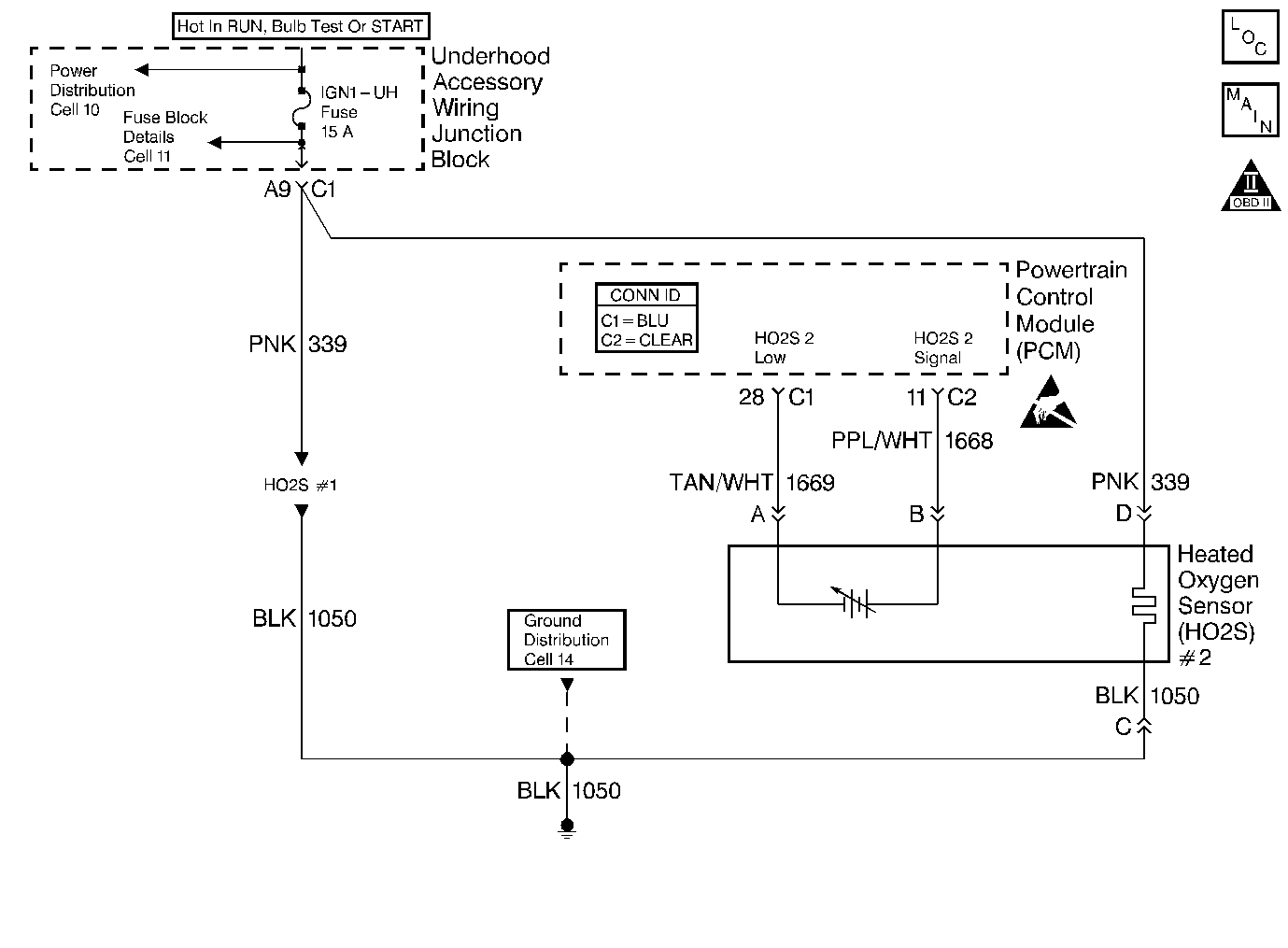
Circuit Description
The PCM supplies a bias voltage of approximately 450 mV between the HO2S signal and the low circuits. When measured with a 10-megohm DMM, the voltage may display as low as 320 mV. The oxygen sensor varies the voltage from approximately 1,000 mV when the exhaust is rich, to approximately 10 mV when exhaust is lean. The PCM constantly monitors the HO2S signal during closed loop operation and compensates for a rich or a lean condition by decreasing or increasing the injector pulse width as necessary. If the HO2S 2 voltage remains at or near the 450-mV bias for an extended time, DTC P0140 will set.
Conditions for Running the DTC
| • | No TP sensor, EVAP system, misfire, IAT sensor, MAP sensor, fuel trim, fuel injector circuit, EGR Pintle Position, ECT sensor, CKP sensor, or MAF sensor DTCs are present. |
| • | The engine run time is more than 200 seconds. |
Conditions for Setting the DTC
The HO2S 1 signal voltage remains between 425 mV and 475 mV for up to 90 seconds.
Action Taken When the DTC Sets
| • | The PCM will illuminate the malfunction indicator lamp (MIL) during the second consecutive trip in which the diagnostic test has been run and failed. |
| • | The PCM will store conditions which were present when the DTC set as Freeze Frame/Failure Records data. |
Conditions for Clearing the MIL/DTC
| • | The PCM will turn OFF the malfunction indicator lamp (MIL) during the third consecutive trip in which the diagnostic has run and passed. |
| • | The history DTC will clear after 40 consecutive warm-up cycles have occurred without a malfunction. |
| • | The DTC can be cleared by using a scan tool. |
Diagnostic Aids
Inspect for the following conditions:
| • | Corroded exhaust flange bolts--Use a DMM in order to ensure that continuity exists between the engine block and the heated oxygen sensor shell. If resistance is excessively high, replace the corroded exhaust flange, attaching hardware as necessary. Refer to General Exhaust System Replacement in Exhaust Systems. |
| • | A malfunctioning HO2S heater or malfunctioning heater circuit--With the ignition ON and the engine OFF, the HO2S voltage displayed on a scan tool should gradually drop to less than 250 mV or rise to more than 600 mV. If not, disconnect the HO2S and connect a test lamp between the HO2S ignition feed and the heater ground circuits. If the test lamp does not illuminate, repair the open ignition feed or the sensor ground circuit as necessary. If the test lamp illuminates and the HO2S signal and low circuits are OK, replace the affected HO2S. Refer to Heated Oxygen Sensor Replacement . |
| • | An intermittent test--With the ignition ON, monitor the HO2S signal voltage while moving the wiring harness and related connectors. If you induce the malfunction, the HO2S signal voltage will change. This procedure may help to isolate the location of the malfunction. |
Many situations may lead to an intermittent condition. Perform each inspection or test as directed.
Important: : Remove any debris from the connector surfaces before servicing a component. Inspect the connector gaskets when diagnosing or replacing a component. Ensure that the gaskets are installed correctly. The gaskets prevent contaminate intrusion.
| • | Loose terminal connection |
| - | Use a corresponding mating terminal to test for proper tension. Refer to Testing for Intermittent Conditions and Poor Connections , and to Connector Repairs in Wiring Systems for diagnosis and repair. |
| - | Inspect the harness connectors for backed out terminals, improper mating, broken locks, improperly formed or damaged terminals, and faulty terminal to wire connection. Refer to Testing for Intermittent Conditions and Poor Connections , and to Connector Repairs in Wiring Systems for diagnosis and repair. |
| • | Damaged harness--Inspect the wiring harness for damage. If the harness inspection does not reveal a problem, observe the display on the scan tool while moving connectors and wiring harnesses related to the sensor. A change in the scan tool display may indicate the location of the fault. Refer to Wiring Repairs in Wiring Systems for diagnosis and repair. |
| • | Inspect the powertrain control module (PCM) and the engine grounds for clean and secure connections. Refer to Wiring Repairs in Wiring Systems for diagnosis and repair. |
If the condition is determined to be intermittent, reviewing the Snapshot or Freeze Frame/Failure Records may be useful in determining when the DTC or condition was identified.
Test Description
The numbers below refer to the step numbers on the diagnostic table:
Step | Action | Values | Yes | No |
|---|---|---|---|---|
1 | Did you perform the Powertrain On Board Diagnostic (OBD) System Check? | -- | ||
2 |
Does the voltage vary outside the specified values? | 425-475 mV | ||
3 |
Does the DTC reset? | -- | Go to Diagnostic Aids | |
4 |
Does the voltage measure less than the specified value? | 150 mV | ||
5 |
Does the voltage measure near the specified value? | 400 mV | ||
6 |
Did you find and correct the condition? | -- | ||
7 |
Did you find and correct the condition? | -- | ||
8 |
Did you find and correct the condition? | -- | ||
9 |
Did you find and correct the condition? | -- | ||
10 |
Did you find and correct the condition? | -- | ||
11 | Replace HO2S 2. Refer to Heated Oxygen Sensor Replacement Did you complete the replacement? | -- | -- | |
|
Important: You must program the replacement PCM. Replace the PCM. Refer to Powertrain Control Module Replacement/Programming . Did you complete the replacement? | -- | -- | ||
13 |
Does the DTC reset? | -- | System OK |
